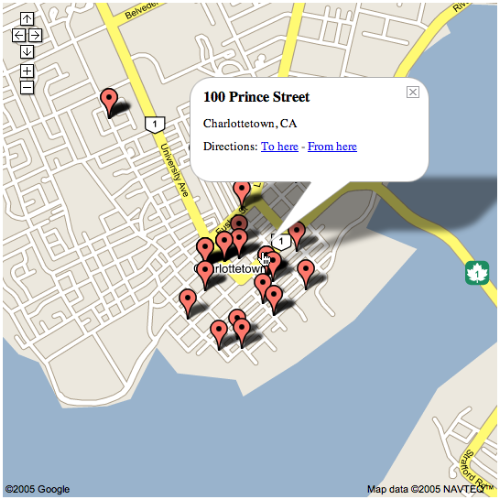MasterCard has an audible brand:
The audible MasterCard brand is a short, memorable combination of three musical tones which enhances the visual and verbal dimensions of the MasterCard brand.
While Air Canada seems fairly successful in flying planes around, they’re not really good at running online contests. Witness today’s quiz in the “Win the Whole World” contest:

As I compose this blog post, I am also:
- Having a Skype chat with Johnnie Moore about social networks.
- Having a Skype chat with Olle Jonsson about Open Bread.
- Updating the Open Bread wiki page.
- Writing the intro and extro for a Plazes radio piece I’m taping for the CBC tomorrow.
- Reading an email from my man at Xerox about using a Docutech to do a 60,000-postcard “mail merge.”
- Monitoring the RSS newsflow.
- Trying to fix Johnny’s phone.
- Doing actual paying work.
There is some danger that my brain might explode.
Today’s “Feminist of the Day” is Helen Adams Keller. Olle Jonsson pointed the way to this RSS feed; it’s excellent daily content: every morning I learn about a new woman, with a brief bio and a pithy quote. Today’s quote from Keller:
“Although the world is full of suffering, it is full also of the overcoming of it.”
Olle Jonsson and I have started a project that we’re calling Open Bread. The question we’re exploring is “do open source practices and principles have application in creating and managing non-digital ‘real world’ projects?”
Charlottetown needs a good bakery: you hear people say this all the time, especially when they’re talking about “downtown revitalization.” The usual route for a bakery to be founded would be for some plucky entrepreneur to come along and invest their time and money in starting a business. But that hasn’t happened. Can open source step into the breach: can the energy of the community, and interested others (like Olle) be harnessed to do what private enterprise hasn’t?
We don’t know. But on the Open Bread page of the Rukapedia we’re going to explore the idea.
I’ve uploaded a set of photographs of Copenhagen washrooms that I took while in Denmark for reboot. Everything in Copenhagen is beautiful, the washrooms especially so.
This is a mostly working hack that uses XSLT to transform the Plazes “traces” XML file into a format suitable for feeding to Google Maps. I used a variety of Google Maps hacking sites to help me put this together. Because Google hasn’t published an API for this feature, it all exists in a shadowing alley world; enjoy at your own risk.
The result, which you can see live here, looks like this:

That’s a map, centred on Charlottetown, showing all of the Plazes that I’ve visited in the last 60 days. If you zoom way, way out, you’ll see additional Plazes in Montreal and Copenhagen too. Here are the building blocks:
- XML locations file (from Plazes)
- XSLT file (transforms the XML file)
- XML file for Google Maps (result of the transformation)
I used TextXSLT on my Mac to transform the Plazes XML file using the XSLT file; there are a variety of other tools available for this, including the handy web-based W3C XSLT Service.
If you look at the source of the demo HTML file (substantially taken from Unofficial Google Maps Embedding How To), you’ll see it refers to “demo.xml,” which is where I saved the XML file that resulted from the transformation.
Notes on the result:
- The XSLT file is somewhat more complicated by the fact that Google Maps needs latitude and longitudes expressed as positive (N and W) and negative (S and E) numbers while Plazes’ traces file uses positive numbers with N, S, E and W appended as appropriate.
- The Plazes on the map are “clickable,” but the name and address of the Plazes don’t show up in Safari (they do show up in Firefox). Not sure why.
- Some of the Plazes are showing up in the wrong location. This isn’t a problem introduced by the demo, or the fault of Google Maps: it appears to be a problem with Plazes’ geocoding system (wherein an address is translated into lat/lon coordinates). The Harborside near Delta Hotel Plaze shows up in the wrong place, for example, as does MarinaGrill.
- The map is the barest possible example of a standalone Google Map: obviously there is much sophistication that could be added.
I can also imagine many ways in which this demo could be enhanced:
- Different colors for “occupied” Plazes (would require a call to the Plazes server, somehow)
- Pop-up could link to Plazes page, could show icons of Plazes users currently at that location, etc.
- Could uses Google’s driving directions layer to show the “trace” — movement from Plaze to Plaze.
I welcome comments and suggestions for improvements and encourage others to build on this.
On Monday, Wednesday, and Friday I pick up Oliver from pre-school at Holland College. I usually walk from the office up Fitzroy Street to Weymouth, then down Weymouth to Kent, and in the back door of the Holland College Charlottetown Center. At the back door I have the choice of stairs or this ramp:

I always take the ramp. Indeed I look forward to talking the ramp. It’s made out of metal grating, and is just bouncy enough so that walking up it provides a very pleasant “floating on air” sensation. The ramp traversal is one of the highlights of my day. At least on Monday, Wednesday, and Friday.
I did some experimenting this afternoon with taking my Plazes XML Traces file and using XSLT to transform it into RSS. I didn’t end up with a complete solution, but I came close:
The problem I ran into is that in the Traces file dates are represented like this:
<location arrival=”2005-06-10”>
Whereas for the RSS file I need something that looks like this:
<pubDate>Sat, 25 Jun 2005 17:36:08 +0100</pubDate>
I need a way of converting dates from one form to another in pure XSLT. I found references here and here that suggested ways around XSLT’s poor date support, but I haven’t implemented them here. As a result, the resulting RSS file is missing a <pubDate>.
I welcome suggestions on how to improve this.
Update: You can use the W3C web-based XSLT processor to do the transformation: the result is RSS that can be fed to an aggregator or newsreader. The pre-packaged URL is here. To reduce load on their XSLT processor, however, please don’t subscribe to this URL.
A new Plazes feature, “Traces,” lets you publish an XML file of all of the Plazes you’ve popped up at. Here’s 60 days of me, for example. Next step: use XSLT to convert this into an RSS feed.
 I am
I am